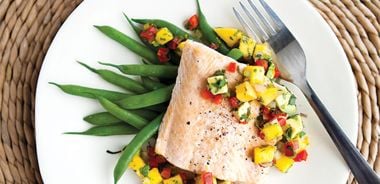Roasted Arctic Char with Avocado Mango Salsa

Much like its cousins salmon and trout, this northern swimmer is a good source of docosahexaenoic acid (DHA) and eicosapentaenoic acid (EPA), two superstar omega-3 fats that may reduce the risk for heart failure and depression.
Unlike salmon, land-based contained farming practices for arctic char aren’t linked to pollution or escapes into the wild, so it’s fine to opt for farmed over wild-caught (which is very hard to come by anyway). Generally milder tasting than salmon, char takes well to lively salsas such as this mango-infused one.
2 ripe mangoes, peeled and cubed
1 ripe avocado, diced
1 red bell pepper, finely diced
1/2 cup (125 mL) finely diced red onion
1 jalapeno pepper, seeded and minced
1/3 cup (80 mL) fresh cilantro, chopped
1/4 cup (60 mL) chopped fresh mint
2 tsp (10 mL) orange zest
2 Tbsp (30 mL) orange juice
1/2 tsp (2 mL) sea salt, divided
1 1/2 lb (750 g) arctic char fillets, cut into 4 equal-sized pieces
1/4 tsp (1 mL) freshly grated black pepper
Combine mango, avocado, bell pepper, red onion, jalapeno, cilantro, mint, orange zest, orange juice, and 1/4 tsp (1 mL) salt in large bowl. Set aside.
Preheat oven to 375 F (190 C). Rinse arctic char under cold water, pat dry with paper towel, and season with remaining salt and pepper. Place fish skin side down on silicone- or parchment paper-lined baking sheet, and bake for 12 minutes, or until flesh is opaque and flakes easily.
Serve fish topped with mango salsa.
Serves 4.
Each serving contains: 482 calories; 39 g protein; 20 g total fat (7 g sat. fat, 0 g trans fat); 28 g total carbohydrates (19 g sugars, 7 g fibre); 435 mg sodium
source: "Catch of the Day", alive #364, February 2013





